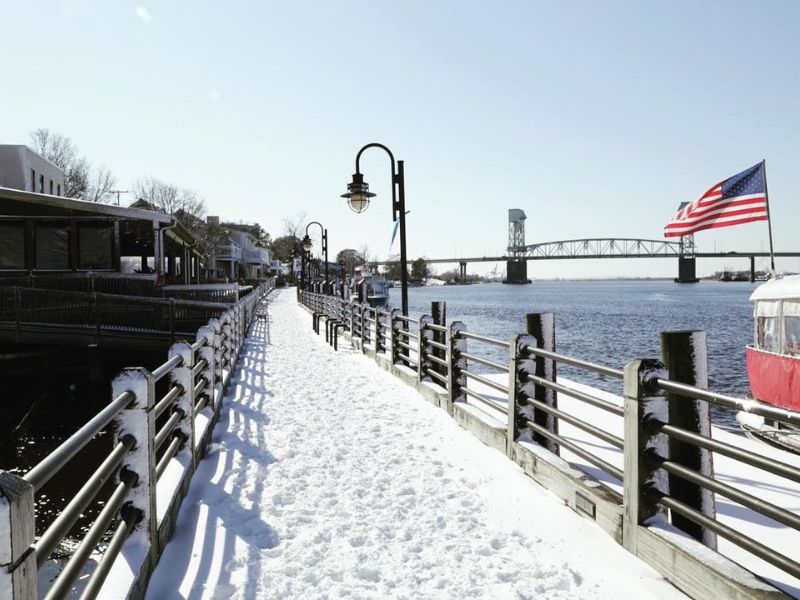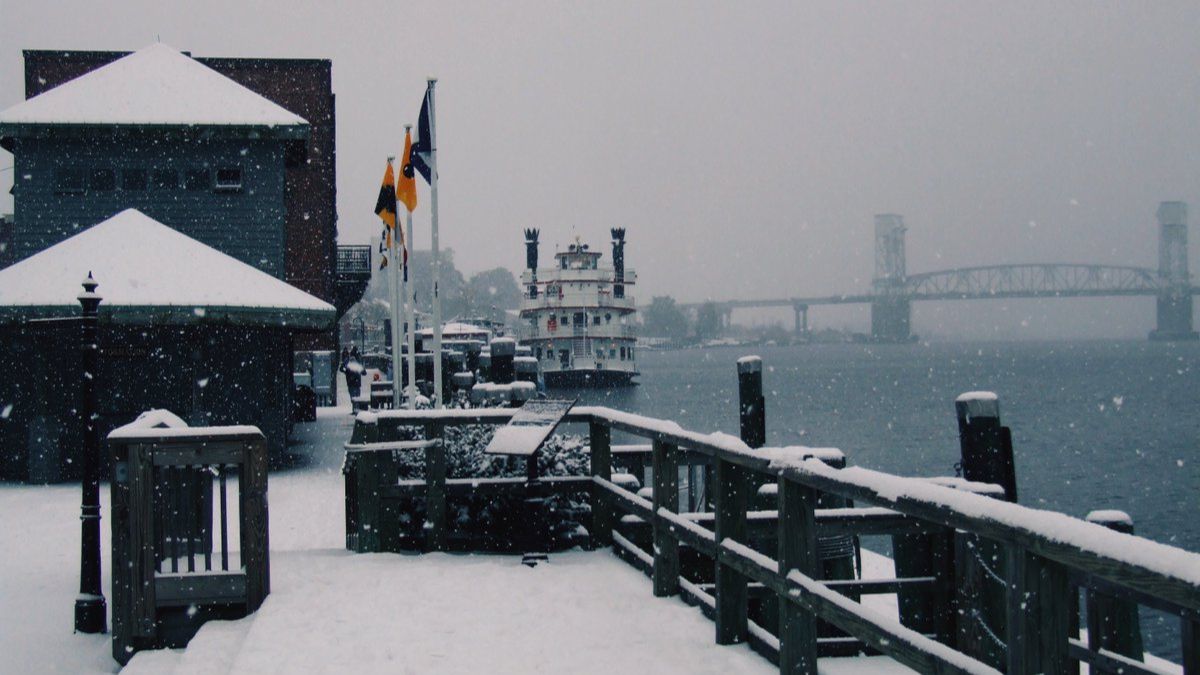Yes, it does snow in Wilmington, North Carolina, although it is relatively rare. Wilmington’s climate is classified as a humid subtropical climate and typically has hot summers and mild winters with limited snowfall. However, the city does experience occasional winter weather events that result in light snowfall.
While snowfall in Wilmington is not a regular occurrence, the occasional light snowfall adds a touch of winter charm to the city’s typically mild climate.
Wilmington, North Carolina, is a popular coastal city known for its warm climate, beautiful beaches, and vibrant culture. However, for those who enjoy the winter season and the charm of snow-covered landscapes, the question often arises: Does it snow in Wilmington, NC?

In this article, we will explore the historical weather patterns of Wilmington and delve into the likelihood of snowfall in the region.
Location Overview
Wilmington is a vibrant coastal city located in the southeastern region of North Carolina, United States. Situated along the Cape Fear River and just a few miles from the Atlantic Ocean, Wilmington offers a unique blend of natural beauty, historic charm, and a bustling urban atmosphere.
Wilmington is situated in New Hanover County and serves as the county seat. It is located approximately midway between the major cities of Jacksonville and Myrtle Beach. The city spans an area of about 52 square miles and is positioned at a latitude of 34.21°N and a longitude of 77.87°W.
One of Wilmington’s defining features is its coastal location. The city has a picturesque coastline stretching for miles, offering sandy beaches, rolling dunes, and breathtaking views of the Atlantic Ocean.
Running through the heart of Wilmington is the majestic Cape Fear River. With its scenic beauty and importance to the city’s maritime heritage, this historic river serves as a focal point for recreation, boating, and water-based activities.
Wilmington’s location offers convenient access to other major cities in the region. It is approximately 120 miles northeast of Myrtle Beach, South Carolina, and about 125 miles southeast of Raleigh, the capital city of North Carolina. Additionally, it is around 200 miles south of the bustling city of Charlotte.
The combination of its coastal setting, proximity to major cities, and access to natural surroundings makes Wilmington an appealing destination for those seeking a blend of beach life, historical charm, and outdoor adventures.
Geography and Climate of Wilmington
The geography of Wilmington significantly impacts its climatic conditions. The ocean acts as a moderating force, leading to milder temperatures and reducing extreme variations. The Gulf Stream contributes to mild winters and keeps the region relatively temperate.
Sea breezes provide relief from the heat, while rainfall patterns are influenced by the proximity to the coast and prevailing winds. Due to its coastal geography, Wilmington is also susceptible to the impact of tropical storms and hurricanes.
Wilmington experiences a humid subtropical climate characterized by hot, humid summers and mild winters. The city enjoys a long warm season, with temperatures often surpassing 90 Fahrenheit during summer. Winters, on the other hand, are relatively mild, with temperatures generally ranging from the mid-40s to the mid-60s Fahrenheit.
While snowfall may be a rare occurrence in Wilmington, precipitation is not. The city receives an average of 57 inches of rainfall per year. This precipitation is typically distributed evenly throughout the year. However, the majority of the precipitation in Wilmington comes in the form of rain rather than snow.
Historical Snowfall Record
Although Wilmington is situated along the coast, which often moderates winter temperatures, it occasionally witnesses snowfall. However, such events are considered rare and generally result in minimal accumulation.
Over the past few decades, Wilmington has experienced an average of one to two snowfall events per year. One notable event occurred in January 2018. A winter storm brought several inches of snow to the city and the surrounding areas.
Winter Season & Snowfall Pattern
Snowfall in Wilmington is infrequent and usually occurs between December and February, which are the coldest months of the year. On average, Wilmington receives one to two snowfall events per year. However, it’s important to note that these snowfalls are often light and result in minimal accumulation.
When snow does fall in Wilmington, it is usually in the form of light dustings or flurries. Accumulations are generally less than an inch, and it is uncommon for the snow to stick around for more than a day. Due to the city’s proximity to the ocean, snow tends to melt quickly.
Locations to Enjoy Snow
While heavy snowfall is rare in Wilmington, North Carolina, there are a few nearby locations where you can enjoy snow during the winter months. Here are some options to consider:
- North Carolina Mountains
Traveling to the western part of North Carolina, particularly the Appalachian Mountains, offers opportunities for snow-related activities. Popular destinations like Boone, Blowing Rock, and Asheville experience more frequent and significant snowfall compared to coastal regions.
- Great Smoky Mountains National Park
Located on the border between North Carolina and Tennessee, the Great Smoky Mountains National Park offers picturesque winter landscapes and the possibility of snow. Hiking trails, scenic drives, and stunning vistas make this park a delightful winter destination.
- Mount Mitchell State Park
Mount Mitchell, situated in western North Carolina, is the highest peak east of the Mississippi River. It boasts an elevation of 6,684 feet and often receives substantial snowfall during the winter season. The park offers trails for hiking, cross-country skiing, and snowshoeing.
- Pisgah National Forest
Another option for snow enthusiasts near Wilmington is Pisgah National Forest. This expansive forest offers various recreational activities, including snowshoeing, cross-country skiing, and winter hiking. The Black Balsam Knob area is known for its scenic winter landscapes and potential snowfall.
- Winter Events and Festivals
Wilmington embraces the holiday season with winter-themed events and festivals. Downtown Wilmington hosts the annual Christmas Tree Lighting Ceremony, holiday parades, and winter markets, providing a festive atmosphere for locals and visitors.
While Wilmington may not be a traditional snow destination, these nearby locations offer opportunities to embrace the beauty and joy of a winter landscape.
Factors Influencing Snowfall
Snowfall in Wilmington, North Carolina, is influenced by several factors. Cold temperatures below freezing are necessary for snow to form. The availability of moisture in the atmosphere, storm systems, and the movement of weather fronts play a role in determining snowfall.
Wilmington’s coastal location and the moderating effect of the Atlantic Ocean can make it challenging for snow to accumulate. Elevation and topography can also influence snowfall, with higher elevations and areas with more significant topographic features experiencing greater chances of snow.
Conclusion
While Wilmington, NC, is not typically known for heavy snowfall, it does experience occasional winter weather events. Snow in the city is generally infrequent and light, with minimal accumulation and short-lived impacts.
Visitors and residents seeking a winter wonderland might need to venture farther inland or to higher elevations in North Carolina to experience substantial snowfall. However, for those who appreciate mild winters with a touch of occasional snow, Wilmington’s climate offers a pleasant balance of warmth.
